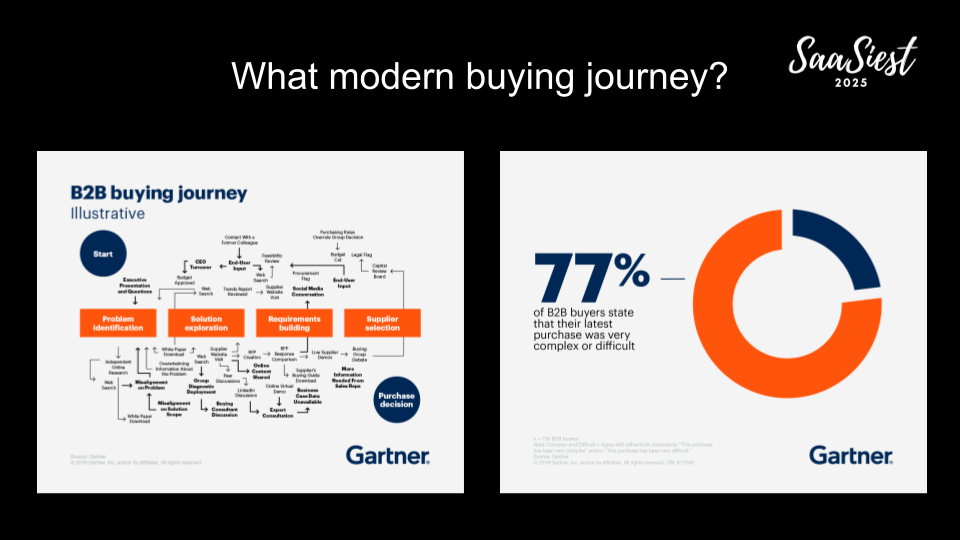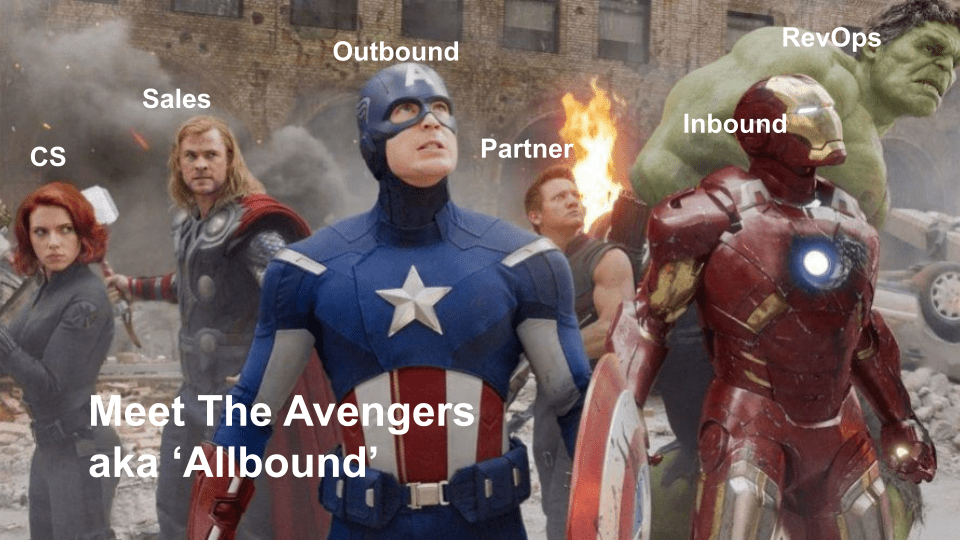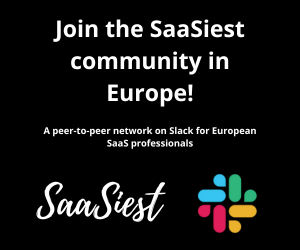The Problem: Stuck in “Inbound vs. Outbound” Thinking
Despite years of talk about “alignment,” most SaaS organizations and teams still frame go-to-market in outdated, siloed terms: inbound vs. outbound, marketing vs. sales, channel vs. direct.
It’s an oversimplification that leaves opportunity — and revenue — on the table.
In today’s complex, noisy, multi-threaded enterprise buying journeys, that binary approach does not reflect how buyers actually purchase.
- Deals can involve 11+ stakeholders
- 77% of recent software buyers say purchasing is “complex”
- And as much as 70% of research is done before speaking to sales
The result? Pipeline stagnation, broken customer experiences, and disconnected teams all chasing their own KPIs.

Why This Matters Now
The shift toward profitable, efficient growth has intensified the need for GTM collaboration. Investors are pushing for better unit economics, predictable revenue, and reduced churn. Buyers expect seamless experiences from first click to renewal.
And with AI accelerating self-directed research, marketing is now responsible for more of the buyer journey than ever before.
The companies that will win in this climate are those that align all GTM motions — inbound, outbound, partner, customer marketing, and sales enablement — into one coordinated growth engine.
This is the heart of the AllBound philosophy that Jillian elaborates on.
Meet Jillian Als
Jillian is the CMO at Queue-It, a company that safeguards websites during mission-critical moments.
She brings 15+ years of global B2B marketing leadership across startups, scale-ups, and enterprises — from high-velocity SMB plays to complex enterprise sales.
Her superpower? Turning GTM silos into high-performance teams that work toward a single commercial goal.
What is AllBound?
“AllBound is not everyone doing everyone’s job,” Jillian says. “It’s about learning from each other, playing to our strengths, and aligning on the same goal so that marketing, sales, CS, partners, and RevOps are truly pulling in the same direction.”
She candidly compares it to assembling the Avengers:
- Inbound (Ironman): Powered by tech and automation, attracting interest
- Outbound (Captain America): Targeting and winning strategic accounts
- RevOps (Hulk): Strengthening GTM infrastructure and analytics
- Customer Success (Black Widow) : Expanding accounts and protecting retention
The common enemy? Pipeline stagnation.

The AllBound Framework
AllBound is not a plug-and-play framework. It’s an ethos that adapts to your GTM model, whether product-led, sales-led, or partner-driven.
It’s iterative, messy at times, and requires ongoing communication and trust.
“It starts with leadership alignment and a shared definition of what AllBound means for your business,” Jillian says.
“From there, it’s about playing to strengths, removing friction for the customer, and measuring success as one team.”
She outlines six key principles any SaaS leader can apply.
1. Alignment Starts at the Top
- Leadership must agree on shared goals, success metrics, and a single source of truth.
- Without executive buy-in, AllBound collapses into old silos.
Ask yourself:
- Does my leadership team share one commercial goal?
- Have we defined what “good” looks like across functions?

2. Over-Communicate
- Weekly team newsletter with KPIs, wins, and priorities
- Monthly marketing reports, crowdsourced from the team and shared company-wide
- “Always Be Presenting” in all-hands, pipeline reviews, and regional meetings
Tip: Communication is not spam if it’s useful, consistent, and transparent.
3. Enable Sales Relentlessly
- Build a Sales Enablement Hub in Airtable with proof points, customer quotes, and data mapped to MEDDIC or other sales frameworks.
- Organize content by industry, region, and sales stage
- Actively remind teams it exists — great content unused is wasted effort
4. Design for Your ICP
- Enterprise-first messaging and lead handling
- Route non-ICP inbound directly to BDRs so AEs can focus on strategic deals
- ABM for must-win accounts, often with bespoke decks or CEO involvement
5. Blend Scalable and Non-Scalable Plays
- Automate low-value touches to free up resources for high-value moments
- Pull in execs for strategic customer engagements
- Build and maintain partner relationships to reach enterprise buyers faster
6. Extend Into Customer Marketing
- Support CS with expansion plays and churn prevention
- Share customer insights with product and GTM to refine ICP and improve retention
The Outcomes of AllBound
When executed well, AllBound delivers:
- Higher pipeline quality (more ICP deals, earlier multi-threading)
- Faster sales cycles through better alignment and enablement
- Improved NRR and GRR with lifecycle-focused engagement
- Lower CAC payback from more efficient resource allocation
- A consistent, frictionless customer experience across every touchpoint
Jillian’s Final Advice
If your teams are still fighting over whether a deal was inbound, outbound, or partner-sourced, it’s time to have a different conversation.
Start with leadership.
Agree on what AllBound means for your company.
Build the plays together.
Measure success as one team.
“AllBound is about removing friction — for your teams and for your customers,” Jillian says.
“It’s a journey, not a destination.”

📺 Watch Jillian Als’ full SaaSiest 2025 keynote here.




